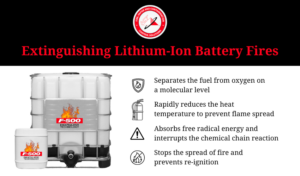Lithium-ion batteries are preparing us for an electric mobility-focused future, providing a compact power source for personal electronics, various modes of transportation, industrial equipment, and more. As smartphones, laptops, hybrids, and electric vehicles remain essential to our modern lifestyle, these batteries bring a significant risk to our lives:
lithium-ion battery fires. Understanding how to extinguish a lithium-ion battery fire is critical to a society that depends on technology.
The complexity of a lithium-ion battery fire lies in its composition of Class A, B, and C materials. In addition to more common combustible materials, such as plastics, lithium-ion batteries contain a flammable liquid medium, electrolyte, and electrical components. These mixed materials pose unique fire hazards that require a specialized approach, differing from the techniques used for conventional fire suppression.
This blog post will explore the causes of lithium-ion battery fires, outline the action items for extinguishing these fires, and highlight Hazard Control Technologies’ advanced solutions for effectively managing these fire emergencies. We will provide essential knowledge and understanding for safely responding to a lithium-ion battery fire, emphasizing the need for more versatile fire suppression agents like those at HCT.
Class A, B, and C Fire Hazards
We’ve learned that li-ion battery fires involve Class A, B, and C
fire classes. This triple threat presents unique challenges for fire suppression because each fire class typically requires a different extinguishing approach.
- Class A: Ordinary combustibles like paper or wood
- Class B: Flammable liquids like alcohol, oil, and gas
- Class C: Electrical equipment, appliances, and wiring
For example, plain water might be an effective Class A fire extinguisher but it’s ineffective against
Class B fires and hazardous in the presence of Class C fires. Similarly, a traditional Class B foam fire extinguisher might successfully smother a flat flammable liquid fire but would be inappropriate in the presence of a three-dimensional lithium-ion battery fire involving multiple fire classes. Understanding the nature of these fires is the first step in preparing to extinguish them, and it equips us with the necessary knowledge to apply the most effective extinguishing methods.

Understanding Lithium-Ion Battery Fires In-Depth
Although these batteries are efficient tools, they can become unstable under certain conditions. Lithium-ion battery fires occur as a result of
thermal runaway. Thermal runaway takes place when lithium-ion battery cells become overheated. The overheating of the battery pack stems from various causes, such as an electrical short circuit, rapid charging, discharging cycles, or even manufacturing defects. This prompts a chain reaction as overheated li-ion cells release flammable, explosive, and toxic off-gases, causing adjacent cells to overheat. This cycle of cell-to-cell ignition creates the perfect environment for a fire or explosion without proper intervention.
Protecting Civilians and First Responders
The first step following any lithium-ion battery fire is to evacuate the immediate area. The next step is to alert the local fire department. Lithium-ion battery fires can be unpredictable and escalate rapidly. Prioritizing safety is essential during a lithium-ion battery fire as they release flammable materials and toxic vapors that can lead to an explosion. This could involve projectiles burning upwards of 1,000°F (538°C) that threaten the welfare of both civilians and first responders if left to burn.
Whether you’re in a residential, office, or industrial setting, allowing a lithium-ion battery fire to spread can have devastating consequences. Ensuring that swift action is taken and the appropriate equipment is made available can halt fire spread, drastically minimizing damage and loss.
Professionals recommend using a specialized extinguishing agent like the F-500 Encapsulator Agent for putting out
lithium-ion battery fires. F-500 EA can be premixed and proportioned at a 3% solution for thorough lithium-ion battery fire mitigation.